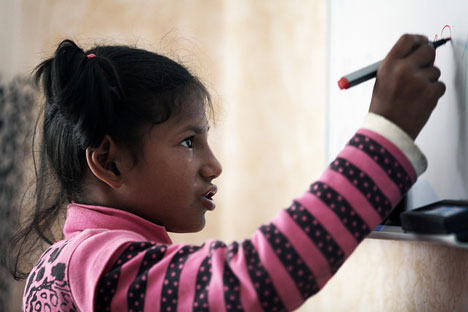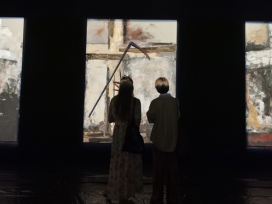For most politicians and bureaucrats, the social inclusion of Roma is a terrifying and complex issue impossible to solve during a typical five-year term in office. After a sporadic few years of small efforts here and there, and decades of very strong but mainly empty rhetoric, Roma remain the most discriminated-against ethnic group in Europe and the most underrepresented within decision-making structures. Due to a chronic lack of expertise among senior management at the level of national government and inter-governmental institutions, tackling the situation of Roma is seen as a professional quagmire. It is very difficult to envision how the incentives required for conventional political parties to tackle this issue – such as opportunities for fast, impressive results, or electoral gains – could become available.

This is about so much more than producing well-intended papers, writes Valeriu Nicolae. Here, a Roma girl in Ukraine writes upon a white board. Photo: Steve Evans. Source:Flickr
Paying lip service, preserving the status quo and avoiding controversy are, from a pragmatic point of view, the best career moves for many of the decision-makers involved. For the past two decades, most of the new appointments in high positions dealing with Roma have led to long periods of inaction, sometimes followed by the reinvention, rediscovery and repetition of previous measures. It is not rare for catastrophic approaches disguised as positive practices in sycophantic reports to make their way back on to the table of the new Roma tsars. This points toward the existence of structural racism within those institutions and the very poor standards of professionalism required for occupying these positions.
Accountability for failures or lack of progress in addressing Roma social inclusion is exceptionally rare for many reasons. Whether due to disinterest, or professional inability on the part of member states and inter-governmental institutions, the kinds of systems that can hold people and institutions accountable simply do not exist. Those in charge develop instead the ability to shift or avoid responsibility. Poor civic and political involvement of Roma within European societies results in the inability of Roma to exert sufficient, or any, political or social pressure to make structures and people accountable.
The outcome is that all the main stakeholders struggle to define clear and distinct responsibilities, or simply avoid them. Creating dedicated, professional, transparent and accountable institutional mechanisms focused not on producing well-intended papers but implementing actions based on strategies might help. With explicit budgets, targets, indicators, and timeframes, such strategies could ensure the success of the EU Framework for National Roma Social Inclusion Strategies.
At the moment, the existing strategies can barely be called strategies. Existing Roma governmental structures are at best irrelevant. In some cases they are in fact detrimental to the social inclusion of Roma.
Roma politicians are, in general, an embarrassment. Roma civil society remains small, weak in terms of influence and pressure, dependent on EU and foreign aid, opportunistic, and inexperienced in dealing with the obstacles and complexities involved in trying to influence EU member states and European agendas.
The economic crisis has also had a significant negative effect. Lack of funding has radicalized or silenced much needed critical voices within Roma civil society. International organizations have started to compete with Roma civil society organizations for available EU funding and, in most cases, won. As a result, we have seen a dramatic decline in the opportunities available for young Roma professionals. The little progress made in previous years regarding cooperation and coordination among stakeholders was disrupted by suspicion and tensions generated by the lack of money.
Long-term strategic thinking gave way to opportunistic approaches meant to ensure the survival of programmes, jobs and organizations. Senior, well-connected people without a job or in danger of losing their jobs were appointed once again to high-level positions dealing with Roma issues. Thereafter, they tend to wait for retirement or a change of fortune.
There are no easy or short-term solutions to change the situation of Roma in Europe. In fact, it will probably get worse before it starts to get better. However, we need to take some basic steps in order to avoid painful and costly crises in the future.
Accountability
Not only governments, but all stakeholders need to come up with concrete Minimal Action Plans (MAPs) that can be monitored and evaluated easily and transparently. People in positions of power need to be held responsible and monitored based not on ambiguous rhetoric but clear indicators. That should include EU Commissioners, ministers, top-level bureaucrats and mayors, but also directors of NGOs paid from public funds. The process of selection for top jobs in governments and inter-governmental institutions but also within Roma NGOs must become fully transparent. The participation of Roma experts needs to evolve from pompous speeches and documents to everyday jobs.
Institutional mechanisms
The pre-accession mechanisms as well as the existing Mechanism for Cooperation and Verification brought about a level of progress in terms of judicial reform and combatting corruption that nobody would have expected in Romania. A similar mechanism focused on Roma social inclusion might be a solution, if it was aimed at stimulating difficult and, at times, otherwise impossible decisions at the national level. There are enough precedents to make the piloting of such a mechanism possible in countries with a significant Roma population. It would make a huge difference in those countries where it could be implemented.
Funding reform
Up until now, funding targeting the social inclusion of Roma failed to produce systemic and sustainable results. It is exceptional, not to mention usually accidental, when existing priorities in the strategies for Roma social inclusion match priorities according to which available funding is distributed. It is even more exceptional when needs, resources (both financial and human) and strategies correlate and can be successfully linked up. In fact, I was unable to find even one example of such a success. One solution might be a European fund for the social inclusion of Roma based on member state contributions and administrated by the European Commission/Council of Europe and a panel of independent experts.
To improve the existing situation we need systemic change. The first steps must be accountability, effective institutional mechanisms, and reform of the way social inclusion of Roma is funded. Addressing widespread European anti-Gypsyism and the role of each of the many stakeholders in addressing the exclusion faced by Roma across all societal spheres in Europe are also vital issues.
The European Roma Platform taking place in Brussels on 16-17 March is in this regard a very pleasant surprise. It puts two fundamental topics high on the agenda: addressing anti-Gypsyism, and multi-stakeholder cooperation. Both require much better coordination, the attention and help of everybody involved. Unfortunately, without first achieving accountability, institutional mechanisms and funding reform, progress on anti-Gypsyism and multi-stakeholder cooperation may prove unrealistic if not impossible.







